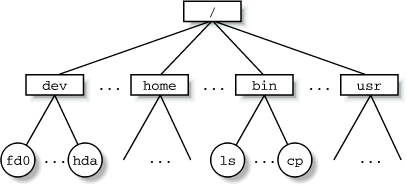1.5. An Overview of the Unix Filesystem
The Unix operating system design is centered on its filesystem, which has several interesting characteristics. We'll review the most significant ones, since they will be mentioned quite often in forthcoming chapters.
1.5.1. Files
A Unix file is an information container structured as a sequence of bytes; the kernel does not interpret the contents of a file. Many programming libraries implement higher-level abstractions, such as records structured into fields and record addressing based on keys. However, the programs in these libraries must rely on system calls offered by the kernel. From the user's point of view, files are organized in a tree-structured name space as shown in Figure 1-2.
Figure 1-2. An example of a directory tree

All the nodes of the tree, except the leaves, denote directory names. A directory node contains information about the files and directories just beneath it. A file or directory name consists of a sequence of arbitrary ASCII characters,[6] with the exception of / and of the null character \0. Most filesystems place a limit on the length of a filename, typically no more than 255 characters. The directory corresponding to the root of the tree is called the root directory . By convention, its name is a slash (/). Names must be different within the same directory, but the same name may be used in different directories. ...
Get Understanding the Linux Kernel now with the O’Reilly learning platform.
O’Reilly members experience books, live events, courses curated by job role, and more from O’Reilly and nearly 200 top publishers.

